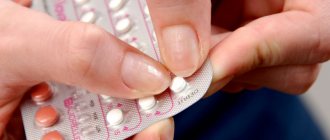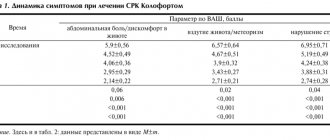Compound
Each capsule contains the following active ingredients:
- 400 mg lipoid ;
- 300 mg of phospholipids (the main one is phosphatidylcholine, which makes up 73-79% of the total);
- 65 mg sodium glycyrrhizinate.
The following substances are contained in each capsule as auxiliary ingredients:
- “extra” or “luxury” grade ethanol;
- butylated hydroxytoluene;
- sunflower or corn oil.
The capsule shell consists of:
- titanium dioxide;
- dyes: red, black and yellow iron oxides;
- gelatin.
Release form
The medicine is available in the form of hard gelatin capsules. The body and cap of the capsule are brown. The contents are an oily paste-like mass. The color of this mass ranges between light yellow and orange-brown. Characterized by a weak specific odor.
Capsules are packaged in blister packs of 10 pieces or in plastic containers of 30, 50, 100, 200 or 300 pieces. Cellular packaging is placed in cardboard packs of 2, 3 or 5 pieces. Each container is placed in a separate cardboard box.
Phosphogliv forte 50 pcs. capsules
pharmachologic effect
Hepatoprotective agent.
Composition and release form Phosphogliv forte 50 pcs. capsules
Capsules - 1 capsule:
- Active ingredients: Phospholipids (Lipoid PPL-400) 400.0 mg [calculated as 100% substance (the main component is phosphatidylcholine 73-79%)] 300.0 mg, sodium glycyrrhizinate (trisodium salt of glycyrrhizic acid) 65.0 mg;
- excipients: butylated hydroxytoluene 0.1 mg, ethyl alcohol “lux” or “extra” (ethanol) 12 mg, sunflower oil or corn oil 22.9 mg;
- Composition of the capsule shell: titanium dioxide, red iron oxide dye, black iron oxide dye, yellow iron oxide dye, gelatin.
30, 50, 100, 200 or 300 capsules in plastic containers with lids made of high-density polyethylene or propylene or polymer jars, sealed with tamper-evident lids with a moisture-absorbing insert.
10 capsules per blister pack made of polyvinyl chloride film and aluminum foil.
1 container or 2, 3, 5 strip packaging along with instructions for use are placed in a cardboard pack.
Description of the dosage form
Hard gelatin capsules No. 0; The body and cap of the capsule are brown.
The contents of the capsule are an oily paste-like mass from light yellow to orange-brown in color with a weak specific odor.
Directions for use and doses
Take orally, during meals, with a small amount of liquid.
Adults take 1-2 capsules 3 times a day, children over 12 years old - 1 capsule 3 times a day.
Pharmacodynamics
Combined remedy. It has membrane-stabilizing, hepatoprotective and antiviral effects.
Phosphatidylcholine (the main component of phospholipids) is the main structural element of cellular and intracellular membranes, capable of restoring their structure and function when damaged, providing a cytoprotective effect.
Normalizes protein and lipid metabolism, prevents the loss of enzymes and other active substances by hepatocytes, restores the detoxification function of the liver, inhibits the formation of connective tissue, reducing the risk of fibrosis and cirrhosis of the liver.
Glycyrate (glycyrrhizic acid and salts) has an anti-inflammatory effect, suppresses the reproduction of viruses in the liver and other organs by stimulating the production of interferons, increasing phagocytosis, and increasing the activity of natural killer cells. It has a hepatoprotective effect due to its antioxidant and membrane-stabilizing activity. Potentiates the effect of endogenous glucocorticosteroids, providing anti-inflammatory and antiallergic effects in non-infectious liver lesions.
In case of skin lesions, due to the membrane-stabilizing and anti-inflammatory effects of the components, it limits the spread of the process and promotes regression of the disease.
Pharmacokinetics
The components of the drug are well absorbed in the intestine, both in the form of the whole molecule and the bioactive products of their hydrolysis (unsaturated fatty acids, choline, glycyrrhetic acid), which, after absorption through the intestinal walls, easily penetrate the liver, lungs, skin and other organs.
Indications for use: Phosphogliv forte 50 pcs. capsules
Viral hepatitis (acute and chronic), fatty liver degeneration (hepatosis), other liver damage (drug, alcohol, toxic), liver cirrhosis, intoxication, psoriasis, neurodermatitis, eczema.
Contraindications
Hypersensitivity to the components of the drug, pregnancy, lactation, children under 12 years of age.
Overdose
Not marked.
Side effects Phosphogliv forte 50 pcs. capsules
With increased individual sensitivity, a skin rash may appear, which disappears after discontinuation of the drug.
Rarely, when daily doses are exceeded, the following may occur: sodium and fluid retention, which is manifested by peripheral edema and increased blood pressure, hypokalemia. If these symptoms appear, depending on their severity, it is necessary to reduce the dose of the drug and/or prescribe spironolactone 50-100 mg per day.
Drug interactions
Not described.
Pharmacodynamics and pharmacokinetics
Pharmacodynamics
Phospholipids, in particular phosphatidylcholine, are structural elements of cell walls and intracellular membranes. Entering the body when taking medication, they promote the restoration of damaged liver cells, inhibit the formation of connective tissue and the replacement of normal tissue with connective tissue elements (prevention of fibrosis ).
Glycyrrhizic acid suppresses inflammatory processes and the ability of viruses to reproduce. This is due to the fact that it stimulates the production of interferons and phagocytosis. Glycyrrhizic acid also has an antioxidant and membrane-stabilizing effect.
Pharmacokinetics
All components of the drug and their active metabolites are very well absorbed in the intestines. through the bloodstream to the organs of the human body, which they actively influence.
Phosphogliv Forte
Phosphogliv forte is a domestic combined hepatoprotector, used mainly for various types of liver pathologies. The problem of treating liver diseases seems to be very relevant today. The number of patients with liver damage (especially toxic) is increasing, if not exponentially, then still sufficiently to cause reasonable concern. There are a lot of reasons for this, the main ones being the rapid growth of industry (and hence the increased risk of “introducing” your liver to any damaging agents), lifestyle, diet, abuse of medications, alcohol and narcotic substances. Unceremoniously invading the body, hepatotoxic substances destabilize the cell membranes of liver cells, accelerate lipid peroxidation, and negatively affect the functioning and regeneration of hepatocytes. In this regard, the use of hepatoprotectors, including phosphogliva forte, seems justified and appropriate. This drug contains two pharmacologically active components: phosphatidylcholine and sodium glycyrrhizinate, each of which makes its own contribution to the final result of treatment.
Without phosphatidylcholine, it is impossible to imagine the structure of cellular and intracellular membranes: this is their main element. When introduced into the body from the outside, this substance is capable of restoring the functions and structure of damaged cells, i.e. it has a cytoprotective effect.
In addition, phosphatidylcholine normalizes protein and lipid metabolism, prevents the loss of enzymes and other necessary substances by liver cells, restores the filtering functions of the liver, prevents the formation of connective tissue structures, reducing the risk of developing fibrotic degeneration and cirrhosis of the liver.
Sodium glycyrrhizinate has anti-inflammatory activity; Thanks to stimulation of the synthesis of interferons, accelerating the process of phagocytosis and activation of T-killers, it inhibits the reproduction of viruses. Due to its antioxidant and membrane-stabilizing properties, it causes a hepatoprotective effect. It enhances the effect of glucocorticosteroids produced by the body, thereby providing an indirect anti-inflammatory and antiallergic effect in liver lesions of non-infectious etiology. Sodium glycyrrhizinate gives every reason to use phosphogliv forte for skin lesions: due to its membrane-stabilizing and anti-inflammatory effect, the substance localizes the pathological process and contributes to its attenuation. Both active components of the drug are well absorbed in the intestines and, after absorption, easily penetrate their main destination - the liver, as well as other organs and tissues.
Phosphogliv forte is available in capsule form. Adults take 1-2 capsules 3 times a day, children over 12 years old - 1 capsule at the same frequency of administration. The drug should be taken with meals, washing down the capsules with water.
Indications for use
The use of Phosphogliv Forte is indicated for:
- acute and chronic forms of viral hepatitis ;
- hepatosis (fatty liver degeneration);
- liver damage caused by medications, alcohol, and other toxins;
- liver cirrhosis;
- intoxications of various origins;
- some skin diseases ( psoriasis , neurodermatitis , eczema ).
Phosphogliv forte caps 300 mg+65 mg pack cont cell/pack card x50
Description of the drug PHOSPHOGLIV FORTE Based on the instructions for use of the drug officially approved in 2021, update date: 09.2015.17
Registration Certificate Holder:
PHARMSTANDARD-LEKSREDSTVA, OJSC (Russia)
Contacts for inquiries: PHARMSTANDARD JSC (Russia) ATX code: A05AX (Other drugs for the treatment of diseases of the biliary tract)
Dosage form
Phosphogliv® Forte
Capsulereg. No.: LSR-008120/08 dated 10/14/08 - Indefinitely Re-registration date: 12/08/15
Release form, packaging and composition of Phosphogliv® Forte
Hard gelatin capsules, No. 0, with a brown body and cap, the contents of the capsules are an oily paste-like mass from light yellow to orange-brown in color, with a weak specific odor.
, 1 caps.
phospholipids (lipoid PPL-400) 400 mg
in terms of the main component - phosphatidylcholine 73-79% 300 mg
sodium glycyrrhizinate (trisodium salt of glycyrrhizic acid) 65 mg
10 pieces. — contour cellular packaging (5) — cardboard packs.
Clinical-pharmacological group: Hepatoprotector with immunomodulatory and antiviral effects Pharmaco-therapeutic group: Hepatoprotective agent
pharmachologic effect
Combined drug.
It has membrane-stabilizing, hepatoprotective and antiviral effects.
Phosphatidylcholine (the main component of phospholipids) is the main structural element of cellular and intracellular membranes, capable of restoring their structure and function when damaged, providing a cytoprotective effect.
Normalizes protein and lipid metabolism, prevents the loss of enzymes and other active substances by hepatocytes, restores the detoxification function of the liver, inhibits the formation of connective tissue, reducing the risk of fibrosis and cirrhosis of the liver.
Glycyrate (glycyrrhizic acid and salts) has an anti-inflammatory effect, suppresses the reproduction of viruses in the liver and other organs by stimulating the production of interferons, enhancing phagocytosis, and increasing the activity of natural killer cells. It has a hepatoprotective effect due to its antioxidant and membrane-stabilizing activity. Potentiates the effect of endogenous glucocorticosteroids, providing anti-inflammatory and antiallergic effects in non-infectious liver lesions.
In case of skin lesions, due to the membrane-stabilizing and anti-inflammatory effects of the components, it limits the spread of the process and promotes regression of the disease.
Pharmacokinetics
The components of the drug are well absorbed in the intestine, both in the form of the whole molecule and the bioactive products of their hydrolysis (unsaturated fatty acids, choline, glycyrrhetic acid), which, after absorption through the intestinal walls, easily penetrate the liver, lungs, skin and other organs.
Indications for Phosphogliv® Forte
viral hepatitis (acute and chronic), fatty liver degeneration (hepatosis), drugs, alcohol, toxic liver damage, liver cirrhosis, intoxication, psoriasis, neurodermatitis, eczema. ICD-10 codes
Dosage regimen
The drug is taken orally with meals. Capsules should be taken with a small amount of liquid.
Adults are prescribed 1-2 caps. 3 times a day, children over 12 years old - 1 capsule. 3 times/day.
Side effect
Dermatological reactions: skin rash that disappears after discontinuation of the drug (with increased individual sensitivity).
Rarely, when daily doses are exceeded, sodium and fluid retention may occur, which is manifested by peripheral edema and increased blood pressure, hypokalemia.
Contraindications for use
pregnancy, lactation period, children under 12 years of age, hypersensitivity to the components of the drug.
Use during pregnancy and lactation The drug is contraindicated for use during pregnancy and lactation.
Use in children Contraindication: children under 12 years of age.
Special instructions If sodium and fluid retention and hypokalemia occur, depending on their severity, it is necessary to reduce the dose of the drug and/or prescribe spironolactone 50-100 mg/day.
Overdose There have been no cases of overdose of Phosphogliv® forte.
Drug interactions Drug interactions with Phosphogliv® forte have not been described.
Storage conditions for Phosphogliv® Forte
The drug should be stored out of the reach of children at a temperature not exceeding 25°C.
Shelf life of Phosphogliv® Forte Shelf life - 3 years.
Terms of sale The drug is available with a prescription.
Contacts for inquiries
PHARMSTANDARD JSC (Russia)
141700 Moscow region Dolgoprudny Likhachevsky pr-d 5B Tel./fax
Analogues of Phosphogliv Forte
Level 4 ATC code matches:
Hepatosan
Sirepar
Hepatomax
Phosphogliv
Thiotriazolin
Karsil Forte
Darsil
Silibor
Karsil
Erbisol
Silimar
Methionine
Remaxol
Enerliv
Laennec
Progepar
Antral
Potassium orotate
Legalon
Hepa-Merz
Drug analogues:
- Antral;
- Apkosul;
- Bonjigar;
- Vimliv;
- Hepa-Merz;
- Gepabene;
- Hepalex;
- Heparete;
- Heparsil;
- Hepatofalk;
- Hepafil;
- Hepaforte;
- Hypoglisil;
- Glutargin;
- Glutarsol;
- Darsil;
- Karsil;
- Levasil;
- Legalon;
- Lecithin;
- Livenziale;
- Livolact;
- Ornitox;
- Remaxol;
- Silibor;
- Triliv.
Price Phosphogliv Forte, where to buy
The price of Phosphogliv Forte in Russian pharmacies is 800-950 rubles for 50 capsules. The cost in Ukrainian pharmacies is 700-900 hryvnia for a similar package.
- Online pharmacies in RussiaRussia
- Online pharmacies in KazakhstanKazakhstan
ZdravCity
- Phosphogliv Forte capsules 300 mg + 65 mg 50 pcs. Pharmstandard-Leksredstva OJSC
1001 rub. order
Pharmacy Dialogue
- Phosphogliv forte (caps. No. 50) FS.-Leksredstva
RUB 1,046 order
- Phosphogliv forte (caps. No. 50) FS.-Leksredstva
1010 rub. order
show more


